
Articles have a number of goals: Some articles drive the common fanboy into a dancing frenzy by presenting janky combos using popular characters and fancy tricks. Other articles find professional player-writers inspiring the casual player to revise ineffective play strategies or make optimal card selections. Still others recount the trials and tribulations of the most recent Pro Circuit event.
The Kingpin’s School of Hard Knocks does not aim to please the masses with fancy previews of upcoming sets; it does intend to develop your knowledge of the latest pro player gossip. It is the proverbial Trial by Fire. The school represents three years on the grind trying to crack that hidden code, break into the upper echelons of peak performance, minimize errors in play, and revise flawed theory. This school is not for the beginners; it is an advanced seminar for the seasoned card flippers.
Review: Lesson 1
Before our summer break, we reviewed a specific way to determine the statistical probability of hitting a given drop in Vs. System (see Lesson 1). We used a statistical method called a hypergeometric distribution to calculate the opportunities, or probability, of landing a specific card at a specified time in the game. Our last homework assignment involved developing some “universal guidelines” for the determination of character counts in a Constructed or Sealed Pack deck.
Homework
Your homework was to look through your current favorite decks and potential decklists and identify the cards that are keys to victory or support a deck’s win condition. Questions that we wanted to answer included: What are the odds of hitting key cards by the turn during which they are needed? Are the drop counts enabling the win condition or hindering it?
Today’s focus will be off-curve Army decks, and our applied example will be the DC Modern Age Injustice Gang Army burn deck.
You may note that this was not the deck selected by Team Alternate Win Condition (TAWC) or by many other top performing players at Pro Circuit Indy 2006. There were decks that clearly exceeded the Injustice Gang Army deck in terms of playability, power level, and consistency. However, this deck works as the perfect example for understanding statistical probability when using Army characters or relying on a very specific set of drops to win a game, and it illustrates beautifully the interaction between hitting those drops and fulfilling the win condition for the deck.
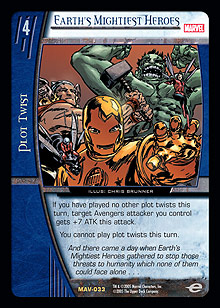 The best players in this game play the best strategies, not just the best cards. When players crack their first packs, they are often awestruck by powerful characters, fancy plot twists, and juicy location effects. As one matures, one comes to realize that interactions, synergy, board advantage, and tempo trump a strategy that relies only on big characters and shiny effects. If you are having trouble understanding this point, pull out your best deck with The Source, Earth’s Mightiest Heroes, or Have a Blast!. These cards contain a great deal of power when considered in a vacuum. However, their applications have been limited due to their lack of synergy with other dominant strategies or their inability to contribute to factors like board advantage and tempo.
The best players in this game play the best strategies, not just the best cards. When players crack their first packs, they are often awestruck by powerful characters, fancy plot twists, and juicy location effects. As one matures, one comes to realize that interactions, synergy, board advantage, and tempo trump a strategy that relies only on big characters and shiny effects. If you are having trouble understanding this point, pull out your best deck with The Source, Earth’s Mightiest Heroes, or Have a Blast!. These cards contain a great deal of power when considered in a vacuum. However, their applications have been limited due to their lack of synergy with other dominant strategies or their inability to contribute to factors like board advantage and tempo.
Theory to Application
The Injustice Gang Army burn deck was tested in the gauntlet for DC Modern Age because it gave players access to effects that were likely going to be strong against Checkmate / Villains United decks and useful in battle with Good Guys. For this lesson, we can use the following decklist:
Characters
19 Infernal Minions, Army
4 Zazzala ◊ Queen Bee, Mistress of the Hive
4 Mantis, Power Parasite
4 Tattooed Man, Living Ink
1 Gorilla Grodd, Simian Mastermind
Plot Twists
4 Criminal Mastermind
4 World War III
4 Forbidden Loyalties, Team-up
4 Infestation
4 Air Strike
4 Secret Files
Locations
4 Hard-Light Storage Tank
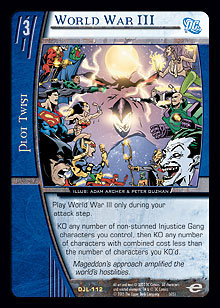 The goal of this deck is to burn the opponent out on or very close to turn 5 using Zazzala’s ability in concert with Infernal Minions, Tattooed Man, Living Ink, and World War III tricks. Essentially, a player wants to drop a Minion on turn 1. As early as possible, the deck wants to flip as many copies of Criminal Mastermind as possible to kick off the card draw. Turn 2 brings another pair of Infernal Minions, followed by Zazzala. On turn 4, Mantis hits the field to feed the Army machine and abuse the character count in the hidden area. This cast crescendos on turn 5 when Tattooed Man, Living Ink comes into play with multiple counters.
The goal of this deck is to burn the opponent out on or very close to turn 5 using Zazzala’s ability in concert with Infernal Minions, Tattooed Man, Living Ink, and World War III tricks. Essentially, a player wants to drop a Minion on turn 1. As early as possible, the deck wants to flip as many copies of Criminal Mastermind as possible to kick off the card draw. Turn 2 brings another pair of Infernal Minions, followed by Zazzala. On turn 4, Mantis hits the field to feed the Army machine and abuse the character count in the hidden area. This cast crescendos on turn 5 when Tattooed Man, Living Ink comes into play with multiple counters.
The Infernal Minions attack into opposing drops and use their text to KO when stunned to increase the number of counters on Tattooed Man, Living Ink. The IG player takes 1 damage and deals 2 damage with Zazzala’s text. Eventually, you repeat this process until your 5-drop is a swollen beater. He attacks without stunning and uses his ability to redistribute his counters across the hidden area for a newly amassed army. Mantis swings for huge damage, and then you can choose to team attack with your swarm using Infestation or, more likely, knock out the rest of the opponent’s board with the aid of the non-targeting World War III. In the end, a player is likely to deal over 50 damage to the opponent and end the game.
Answering the Tough Questions
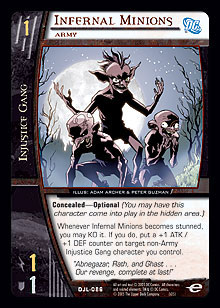 It’s a creative game plan that’s fun to execute. However, a strong player might grow weary of the deck’s heavy reliance on bringing together a specific curve and group of plot twists to satisfy the win condition. When creating and honing this decklist, there are several questions that a player must ask. One question may be: What is the likelihood of hitting three copies of Infernal Minions by turn 2?
It’s a creative game plan that’s fun to execute. However, a strong player might grow weary of the deck’s heavy reliance on bringing together a specific curve and group of plot twists to satisfy the win condition. When creating and honing this decklist, there are several questions that a player must ask. One question may be: What is the likelihood of hitting three copies of Infernal Minions by turn 2?
To answer this question, one might employ the statistical strategy discussed during Lesson 1. If the deck is packing four copies of a character and that character is used as a mulligan condition, then a player has a 52% chance of seeing that specific character on turn 1. However, our question for the Army deck is somewhat more complex.
Instead of a single copy on turn 1, we are looking for that card in triplicate by turn 2. After making the appropriate changes to the formula (referenced in the first lesson and again at the end of this article), we find that the probability of hitting three of the same card when you are playing only four copies falls below 1%.
Luckily, Army characters are not restricted to four copies. In fact, this deck increased the number of available Infernal Minions to twenty. Adjust the appropriate number in our formula and we find that the probability is now 28.4%. If we count the Hard-Light Storage Tanks as Minions (which is statistically dangerous because you cannot use two of them on turn 2 if you draw both, and when you draw a Minion using the location’s effect, your number of available Minions is altered for future turns), one might hit three copies of Infernal Minions by turn 2 in approximately 30% of the games played. That’s not too bad for a three-card combo.
But here comes the advanced alteration: Anyone can guestimate that running a ton of characters can increase your chance of hitting that character. However, in this deck, it was decided that having a copy of Gorilla Grodd might be useful for a turn 6 play. With twenty copies of the Minions, there did not appear to be room for it. Statistically speaking, a player may not be comfortable with hitting the optimal early game in slightly less than one out of three games. However, if we run the statistics for nineteen copies of Infernal Minions, we find that the probability of hitting three minions by turn 2 is 28%. This would free up a space for Gorilla Grodd at the end of your character curve while sacrificing very little in terms of hitting your Minions at the desired time. A strong player might run through three, four, five, or more statistical configurations before deciding on a final count in an Army deck. In this case, you gain diversity in drops and lose a very minute amount of consistency. The same adjustments may be conducted to secure plot twist ratios, ATK pump counts, or other card additions.
The Law of Diminishing Returns
In deckbuilding, there is a law of diminishing returns. You can play too many of a good card. The best players realize that a deck could lose more games while hitting its characters very consistently but missing its plot twists than by missing a bit on the character drops but hitting its good tricks. This holds especially true in the Draft and Sealed Pack formats. The difference between an extra Army character and an extra trick or late game drop in the Army deck demonstrates one instance in which this law of diminishing returns is evident. In fact, a player gains very little statistical advantage with each minion over sixteen. However, the collective effect of having four more minions is significant over the course of a ten-game day.
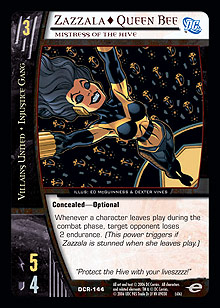 A second question may be asked of this deck. Zazzala ◊ Queen Bee, Mistress of the Hive seems to be the foundational character and represents its win condition. In the Checkmate builds, Ahmed Samsarra is a key character, and in Golden Age, some feel like Dr. Doom, Diabolic Genius is essential. In any case, a player must identify the axle upon which the deck’s wheels turn. In this case, that axle is Zazzala. The question we want to answer is: What are the chances of hitting the Queen Bee by turn 3? If we mulligan for Zazzala, we have a 66% chance of hitting her by turn 3. If we count each copy of Secret Files as a potential copy of Zazzala (assuming that we can fulfill the Injustice Gang clause of Secret File’s cost), then we jump up to a 90% chance of finding our axle. So, in one out of our ten matches, we may miss her. Those odds are not particularly bad given the average shot at hitting a 3-drop in most decks, but they are also not outstanding. If you hit and activate a copy of Criminal Mastermind on turn 1, then you have a 94% chance of landing Zazzala. Those statistics are almost as good as the odds that my team (TAWC) had of hitting Ahmed at Pro Circuit San Francisco (97%). However, one may not mulligan for both Zazzala and an Infernal Minions with a copy of Criminal Mastermind.
A second question may be asked of this deck. Zazzala ◊ Queen Bee, Mistress of the Hive seems to be the foundational character and represents its win condition. In the Checkmate builds, Ahmed Samsarra is a key character, and in Golden Age, some feel like Dr. Doom, Diabolic Genius is essential. In any case, a player must identify the axle upon which the deck’s wheels turn. In this case, that axle is Zazzala. The question we want to answer is: What are the chances of hitting the Queen Bee by turn 3? If we mulligan for Zazzala, we have a 66% chance of hitting her by turn 3. If we count each copy of Secret Files as a potential copy of Zazzala (assuming that we can fulfill the Injustice Gang clause of Secret File’s cost), then we jump up to a 90% chance of finding our axle. So, in one out of our ten matches, we may miss her. Those odds are not particularly bad given the average shot at hitting a 3-drop in most decks, but they are also not outstanding. If you hit and activate a copy of Criminal Mastermind on turn 1, then you have a 94% chance of landing Zazzala. Those statistics are almost as good as the odds that my team (TAWC) had of hitting Ahmed at Pro Circuit San Francisco (97%). However, one may not mulligan for both Zazzala and an Infernal Minions with a copy of Criminal Mastermind.
A final question involves one other key card used to fulfill the win condition: What are the chances of landing a single copy of World War III by turn 5? With four copies, a player has a 66% chance of hitting WWIII without a mulligan (the mulligan, if you’ve noticed, lets you jump two whole turns of statistical probability when based on a single card out of a playset of four copies). If you hit Criminal Mastermind on turn 1, then you have an 88% chance of hitting WWIII when you need it on turn 5. With a mulligan, your odds would be greater, but we’ve already established the importance of finding our axle.
Overall, I like my game-winning cards to show up at a rate greater than 90% of the time on the turns when I need them. In the end, the odds of hitting Zazzala were attractive, but it was less attractive to think about the odds of hitting Zazzala but also missing too many Minions in the early game. Overall, the deck needed to bring multiple Army characters together while hitting the 3-, 4-, and 5-drops, and usually needed some plot twist support in the form of World War III.
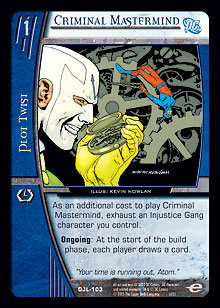 The stats really improve with an early game Criminal Mastermind. If you get two Masterminds going, you will almost always hit everything. Before we finally ditched the deck for bigger and better things, our team fooled around with changing the mulligan condition to Criminal Mastermind with an Infernal Minions to improve consistency. Just for kicks, you may want to calculate the chance of hitting a single copy of one card of which you have nineteen copies, along with a single copy of another card of which you only have four copies, by your first turn with a mulligan.
The stats really improve with an early game Criminal Mastermind. If you get two Masterminds going, you will almost always hit everything. Before we finally ditched the deck for bigger and better things, our team fooled around with changing the mulligan condition to Criminal Mastermind with an Infernal Minions to improve consistency. Just for kicks, you may want to calculate the chance of hitting a single copy of one card of which you have nineteen copies, along with a single copy of another card of which you only have four copies, by your first turn with a mulligan.
The next class will deal with probability in a curve deck. Both the short and longer curves will be reviewed, and as with this article, our focus will be on hitting the key cards, the use of statistics in the determination of optimum drop counts, and the statistical advantage that the short curve has over its longer counterpart. Homework for the next class includes dissecting the best characters from your favorite curve decks. With a mulligan, what is the chance of hitting your key character? Without a mulligan, what is the chance of hitting your 5-drop? How much search is enough?
If you would like technical assistance, my office hours are 9 AM to 3 PM EST. Shoot those email questions to tampakingpin@yahoo.com.
The Formula
For the math geeks among us, a general notation using X! / (Y! * (X-Y)!) can explain what I am about to simplify (if you just went blank, then move to the next paragraph). I prefer to think of the formula like this: X is the specific card or card type in your deck; Y is the total number of cards in the deck; Z is the number of cards you have drawn; and N is the number that you are interested in discovering. N = (X, n) * (Y - X, Z - n) / (Y, Z).
For the Less Math-Inclined
For those of you now un-blanking, welcome to the more lucid section of the math instruction. Take that formula and use it in MS Excel. The syntax is HYPGEOMDIST (N, Z, X, Y).
See you soon!